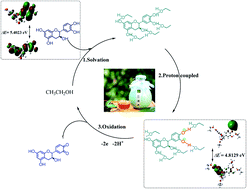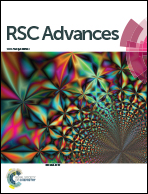Proton-coupled electron transfer of catechin in tea wine: the enhanced mechanism of anti-oxidative capacity†
Abstract
Tea wine is a Chinese traditional alcoholic drink made by cereal and tea leaves. It is rich in tea polyphenols, caffeine, amino acids, and protons and possesses various healthcare functions. In this work, electrochemical methods, as well as density functional theory (DFT) calculations, were adopted to reveal the proton-coupled electron-transfer process of catechin in tea wine. The electrochemical results showed that the catechin preferred hydrogen-bonding with ethanol and formed molecular clusters. Thus, the direct electron-transfer process of catechin changed to proton-coupled electron transfer. This procedure reduced the energy barrier of the redox reaction and enhanced the anti-oxidative capacity. Subsequently, DFT calculations were employed to explore the bond length, bond energy, and HOMO–LUMO energy gap of catechin, which confirmed the above-mentioned mechanism. Our work offers some positive value for the scientific promotion of traditional food and a greater understanding of the health mechanisms in terms of chemistry.



 Please wait while we load your content...
Please wait while we load your content...